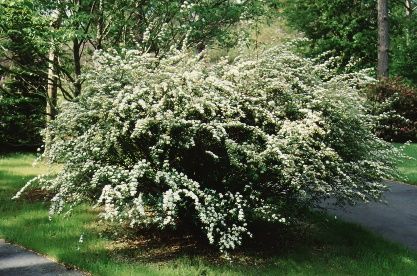Introduction
This easily grown, deciduous spiraea has fine-textured, small leaves on long, graceful, arching branches. The pure white, spring flowers appear in dense, bouquet-like clusters all along the stems, giving the plant the appearance of a foaming fountain when in full bloom.

Credit: Edward F. Gilman, UF/IFAS
General Information
Scientific name: Spiraea cantoniensis
Pronunciation: spy-REE-uh kan-toe-nee-EN-sis
Common name(s): Reeve's spiraea, bridal-wreath, Reeves' meadowsweet
Family: Rosaceae
Plant type: shrub
USDA hardiness zones: 7 through 9 (Figure 2)
Planting month for zone 7: year-round
Planting month for zone 8: year-round
Planting month for zone 9: year-round
Origin: native to temperate Asia
Invasive potential: not considered a problem species at this time and may be recommended by UF/IFAS faculty (reassess in 10 years)
Uses: mass planting; specimen; container or above-ground planter; foundation
Availability: somewhat available, may have to go out of the region to find the plant

Credit:
Description
Height: 4 to 8 feet
Spread: 4 to 8 feet
Plant habit: round
Plant density: moderate
Growth rate: moderate
Texture: fine
Foliage
Leaf arrangement: alternate
Leaf type: simple
Leaf margin: serrate
Leaf shape: rhomboid
Leaf venation: pinnate
Leaf type and persistence: deciduous
Leaf blade length: less than 2 inches
Leaf color: green
Fall color: yellow
Fall characteristic: showy
Flower
Flower color: white
Flower characteristic: spring flowering; pleasant fragrance
Fruit
Fruit shape: unknown
Fruit length: less than 0.5 inch
Fruit cover: dry or hard
Fruit color: brown
Fruit characteristic: inconspicuous and not showy
Trunk and Branches
Trunk/bark/branches: not particularly showy; typically multi-trunked or clumping stems
Current year stem/twig color: brown
Current year stem/twig thickness: thin
Culture
Light requirement: plant grows in full sun
Soil tolerances: slightly alkaline; clay; sand; acidic; loam
Drought tolerance: moderate
Soil salt tolerances: poor
Plant spacing: 36 to 60 inches
Other
Roots: usually not a problem
Winter interest: no special winter interest
Outstanding plant: not particularly outstanding
Pest resistance: no serious pests are normally seen on the plant
Use and Management
Reeve's spiraea makes an attractive specimen planting, working well also as a hedge or mixed with other flowering shrubs. It needs six to eight feet to develop into the natural fountain or mound-like habit. Little pruning is necessary, but plants can be trimmed after flowering to control size and maintain compact growth. Flowers are produced on year-old growth so pruning should be done just after flowering.
Reeve's spiraea grows best in full sun or high, shifting shade. Plants receiving less than four or five hours of direct sun become thin and flower poorly. Plant on four- to five-foot centers to form a mass planting. As with other white-flowering plants, place in front of other green-foliaged plants or other dark background to show the best flower display.
The cultivar 'Lanceata', or double Reeve's spiraea, is more often seen in the south than the other species and reaches a height of 4 to 6 feet. Double Reeve's spiraea is almost evergreen in the deep south and parts of California.
Propagation is by seeds, cuttings, or division.
Pests and Diseases
No pests are of major concern.
Spiraea aphid causes leaf curling and is usually found on the shoot tips or in flower clusters. Heavy infestations reduce the amount of growth produced by the plant. The insects can be dislodged with high pressure water spray from the garden hose.
Oblique-banded leaf roller rolls and webs the leaves together. Hand pick infested leaves.
Inspect the stems of unhealthy-looking shrubs for scales. Use sprays of horticultural oil to minimize injury to predators that help control scales.
Fire blight causes the leaves to appear scorched. The twig tips die back and dead leaves hang on blighted branches. Prune out infected branches and avoid high nitrogen fertilizer.
A leaf spot may infect the leaves.
Powdery mildew forms a white coating on the leaves.